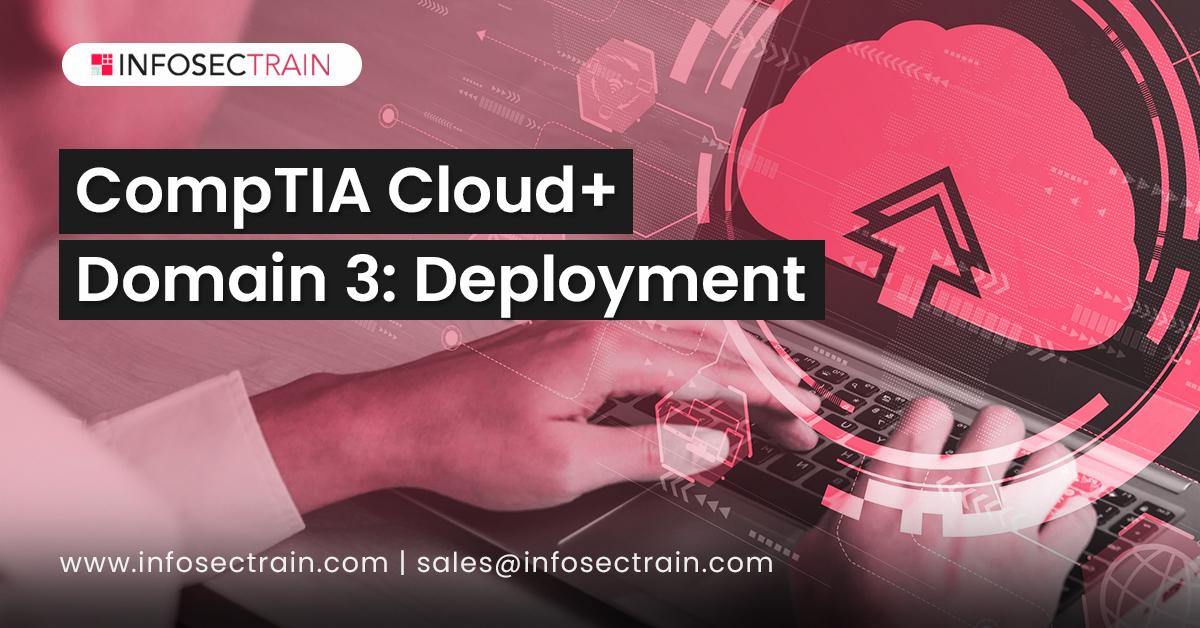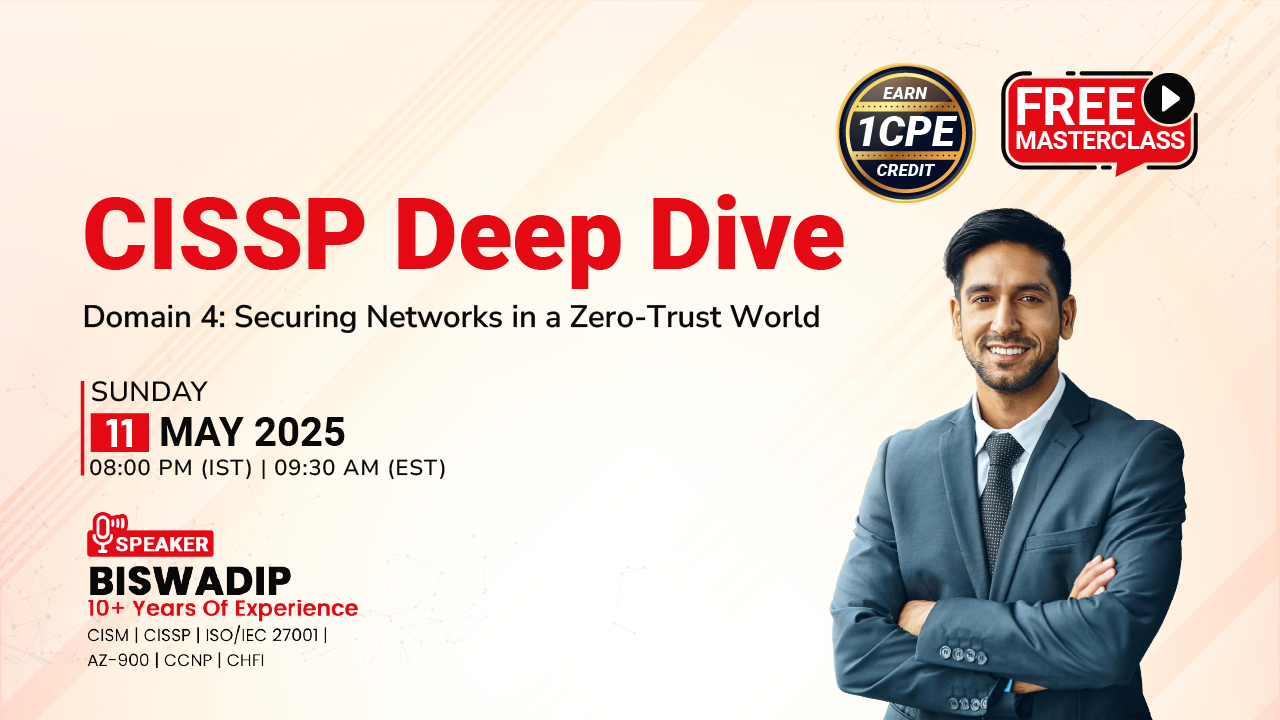CompTIA Cloud+ Domain 3: Deployment

Domains of the CompTIA Cloud+

CompTIA Cloud+ certification comprises a total of five domains:
- Domain 1: Cloud Architecture and Design 13%
- Domain 2: Security 20%
- Domain 3: Deployment 23%
- Domain 4: Operations and Support 22%
- Domain 5: Troubleshooting 22%
We will discuss the third domain that is ‘Deployment’.
Deployment
Deployment is an essential component of any software solution. In the same way, it is very crucial for a cloud solution as well. This domain comprises the highest weightage of 23% in the CompTIA Cloud+ exam. It validates a candidate’s ability to deploy, migrate, provision, and configure cloud solutions. This domain will explain all about the components, storage, networking solutions, compute size, and migrations for cloud solutions. Cloud solutions can be deployed using the Software as a Service (SaaS), Platform as a Service (PaaS), or Infrastructure as a Service (IaaS) model.
1. Integrate components into a cloud solution: In this sub-domain, we will learn to integrate components into a cloud solution in a given scenario. We will learn about subscription services, provisioning resources, applications, deploying Virtual Machines (VMs) and custom images, templates, identity management, containers, auto-scaling, and post-deployment validation. Subscription services explain all about file subscriptions, communications, email, Voice over IP (VoIP), messaging, collaboration, Virtual Desktop Infrastructure (VDI), directory and identity services, cloud resources such as IaaS, PaaS, and SaaS. Provisioning resources explains all about compute, storage, and network. Serverless will be covered under applications. Templates will explain OS templates and solution templates. Containers will define configure variables, configure secrets, and persistent storage.
2. Provision storage in cloud environments: In this sub-domain, we will learn provision storage in cloud environments in a given scenario. It explains types, tiers, Input/Output Operations Per Second (IOPS) and read/write, protocols, Redundant Array of Inexpensive Disks (RAID), storage system features, user quotas, hyperconverged, and Software-Defined Storage (SDS). In types, we learn about block types such as Storage Area Network (SAN), and zoning, file types such as Network Attached Storage (NAS), and object types such as tenants, and buckets. Tiers provide an understanding of flash, hybrid, spinning disks, and long-term tiers. Protocols will incorporate Network File System (NFS), Common Internet File System (CIFS), Internet Small Computer System Interface (iSCSI), Fibre Channel (FC), and Non-Volatile Memory express over Fabrics (NVMe-oF). Redundant Array of Inexpensive Disks (RAID) have 0, 1. 5, 6, and 10. The storage system features explain compression, deduplication, thin provisioning, thick provisioning, and replication.

3. Deploy cloud networking solutions: In this sub-domain, we will learn about deploying cloud network solutions in a given scenario. It provides an in-depth understanding of services, Virtual Private Network (VPN), virtual routing, network appliances, Virtual Private Cloud (VPC), VLAN/VXLAN/GENEVE, Single Root Input/Output Virtualization (SR-IOV), and Software-Defined Network (SDN). In services, we learn about Dynamic Host Configuration Protocol (DHCP), Network Time Protocol (NTP), Domain Name Server (DNS), Content Delivery Network (CDN), and IP Address Management (IPAM). In Virtual Private Network (VPN), we learn about different types of networks like site-to-site, point-to-point, point-to-site, IP Security (IPSec), and Multi-Protocol Label Switching (MPLS). We understand dynamic and static routing, Virtual Network Interface Controller (VNIC), and subnetting in virtual routing. Load balancers and firewalls fall under network appliances. In Virtual Private Cloud (VPC), we learn about the hub and spoke, and peering.
4. Configure the appropriate compute sizing for a deployment: We will learn about configuring the appropriate compute sizing for deployment in a given scenario in this sub-domain. It provides knowledge about virtualization, Central Processing Unit (CPU)/Virtual CPU (VCPU), Graphics Processing Unit (GPU), clock speed/Instructions Per Cycle (IPC), hyperconverged, and memory. We learn about type 1 hypervisors and type 2 hypervisors, Simultaneous Multi-Threading (SMT), dynamic allocations, and oversubscription in virtualization. We also know about the shared virtual Graphics Processing Unit and the pass-through Graphics Processing Unit. In memory, we learn about dynamic allocation and ballooning.
5. Perform cloud migrations: In this sub-domain, we will learn about performing cloud migrations in a given scenario. It provides an in-depth understanding of Physical to Virtual (P2V) migrations, Virtual to Virtual (V2V) migrations, cloud-to-cloud migrations, storage migrations, and database migrations. In cloud-to-cloud migrations, we learn about vendor lock-in and PaaS or SaaS migrations, including Access Control Lists (ACLs) and firewalls. In storage migrations, we have block storage migration, file storage migration, and object storage migration. In database migrations, we learn about cross-service migrations, relational, and non-relational migrations.
CompTIA Cloud+ with InfoSecTrain
For expert knowledge and an in-depth grasp of Cloud security, consider taking the CompTIA Cloud+ Certification Training Course from InfoSecTrain. Instructors that are highly trained and experienced are in charge of this training. With our well-versed and experienced teachers, we are among the leading training providers in the globe. The courses will assist you in grasping the fundamental principles and providing a thorough understanding of the subject. This certification is well worth every dollar and minute you put into it.






 1800-843-7890 (India)
1800-843-7890 (India)